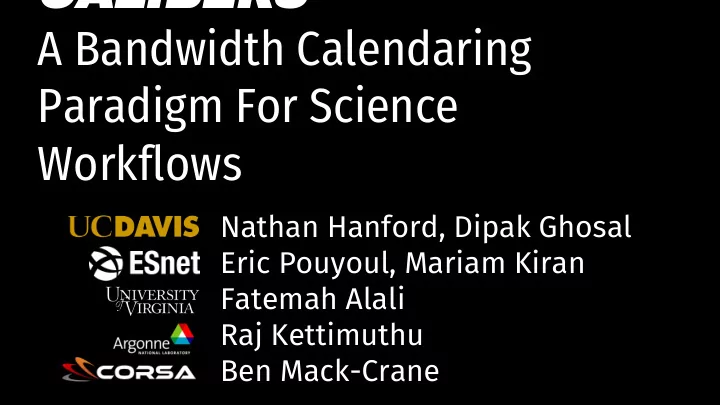

CALIBERS A Bandwidth Calendaring Paradigm For Science Workflows Nathan Hanford, Dipak Ghosal Eric Pouyoul, Mariam Kiran Fatemah Alali Raj Kettimuthu Ben Mack-Crane
Should the user have to do resource allocation?
Motivation Mission-Critical Science Workflows: Hurricane tracking, Astronomy, etc. Data needs to be in SAN storage or a burst buffer by a strict deadline Negative consequences to missing deadline Goal of predictability over raw performance
Talk Outline 1. Background 2. Implementation 3. Results 4. Conclusion
Background
Building blocks TCP: survivable, scalable and fair (for the most part) (But fairness isn’t always desired) Software-Defined Networks: rapidly reconfigurable Switch-based shaping: avoids interference End-system pacing: efficient throughput control Intent-driven network for deadline awareness ESnet’s transcontinental 10 Gbps SDN Testbed and OSCARS circuits
Contemporary Solutions TEMPUS: Performance-oriented DNA/AMOEBA: Uses traffic classification B4: Performance-focused SWAN: Dynamic dataplane reconfiguration Our contributions: 1. Considering end-systems we can’t control 2. Exclusively dealing with elephant flows
Implementation
CALIBERS Architecture Currently single-controller implemented as a RESTful python orchestrator. Participating DTNs run a RESTful Python client and shape using CoDel Corsa DP2000 Series edge switches use 3-color meters to guarantee non-participating clients don’t interfere with bandwidth reservations, and are dynamically controlled through a REST API GridFTP (Globus) provides the actual transfers Runs on OSCARS circuits
High-level Architecture
Solution Approach 1. Find the minimum rate, Rmin = file size / deadline 2. Find the maximum residual rate (Rresid) a. Assign Rresid to the new request as long as Rresid >= Rmin b. Transfer the file as fast as possible to free up resources for future requests 3. If Rmin is not available a. Reduce rate of other flows 4. When a flow completes, redistribute its bandwidth to ongoing flows 5. Pacing and bandwidth redistribution are performed based on four heuristic algorithms combining two concepts: a. Global and local optimization b. Shortest Job First (SJF) and Longest Job First (LJF)
Dynamic Pacing Algorithm 1) Determine which flows should be considered for pacing: • Global approach: • the scheduler consider all flows when distributing any residual capacity • Local approach: • The scheduler consider only flows that span the bottleneck link when distributing residual capacity • Bottleneck link defined as the link with a flow that has the longest completion time, i.e., the link that will stay busy the longest 2) Based on the selected flows, determine which flow should be paced first • Shortest Job First (SJF): • Start with the flow with the smallest remaining data to be transferred • Longest Job First (LJF): • Start with the flow with the largest remaining data to be transferred
Evaluation: Metrics Network Utilization Reject Ratio Performance Index: the difference between network utilization and reject ratio The larger the difference the better Ideally we want 100% utilization and a reject ratio of 0%
Simulated Algorithm Evaluation Utilization Negligible difference between the 4 algorithms with small epoch Reject ratio Based on the simulated network (G-scale), local approach optimization is sufficient As arrival rate increases: Lower performance even Utilization increases though reject ratio is because Reject ratio increases utilization is low
SJF vs. LJF The difference in performance between SJF and LJF becomes more apparent with a longer epoch duration: • with LJF the makespan time of all flows reduced • hence resources are freed up faster for future requests Lower performance with larger epoch as arrival rate increases: • requests are aggregated making the scheduler less flexible At low arrival rate, higher performance with 5-min: • The utilization is higher because requests are aggregated, hence higher performance
Comparison with TCP Fairness
Our Live Demonstrations ● Two simultaneous tests: one with unpaced TCP, the other with CALIBERS ● 6 senders per test, for 12 total senders from around the United States and the world ● Receiver will be the SCinet DTN in the NOC booth # 1081 ● Controllers will be located in Atlanta, and operated from the DOE booth # 613 ● Goal is to meet or exceed deadlines beyond the capability of TCP
Conclusions ● Do resource allocation for the user ● Allow jobs to “sprint” past others to meet their deadlines ● Offer a different kind of service from OSCARS circuits ○ (Which, in turn, offer a different kind of service from dark fiber connections). ● CALIBERS does pacing, metering, and shaping ○ Prevents interference ● All pacing, metering, and shaping is done in hardware for scalability
Future Work ● Very Near Future: Our Demo! ○ DOE Booth # 613: ○ 4PM Tuesday ○ 11AM Wednesday ○ 1PM Thursday ● Longer-term ○ Distributed controller ○ Routing ○ Algorithm refinement ● Questions? nhanford@ucdavis.edu
Recommend
More recommend